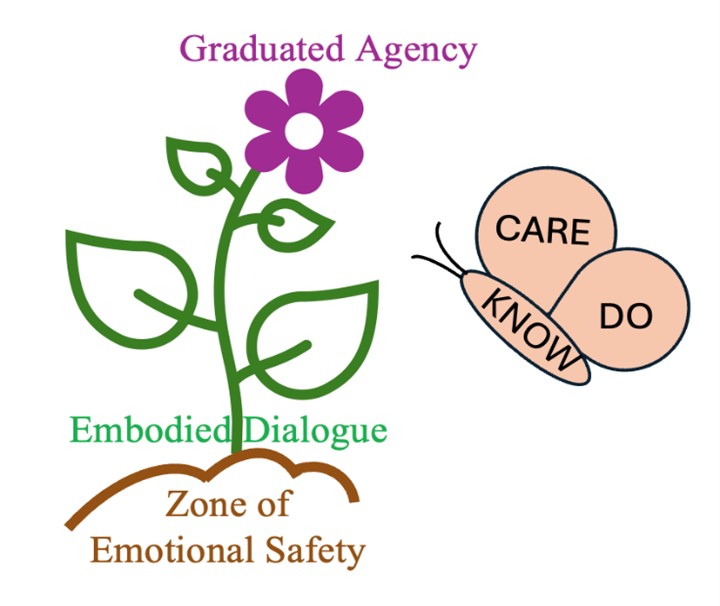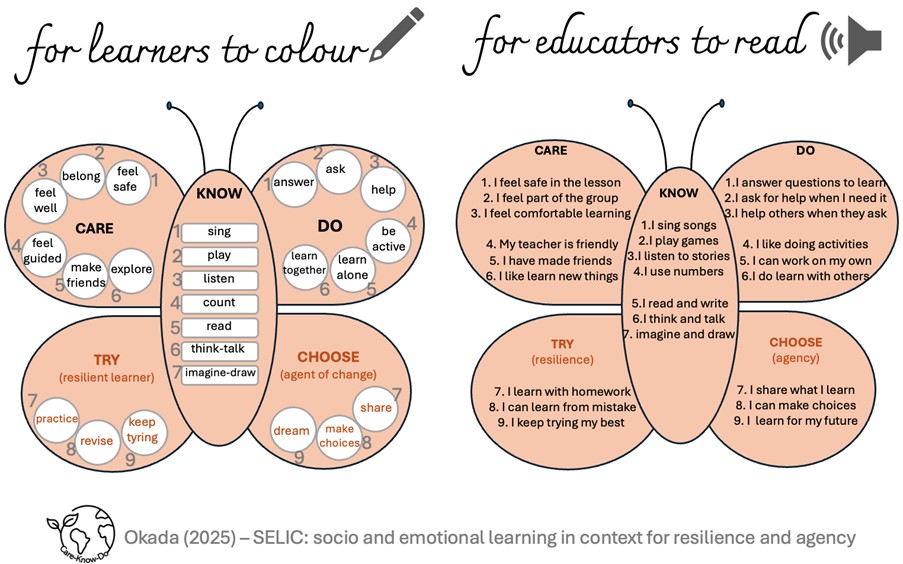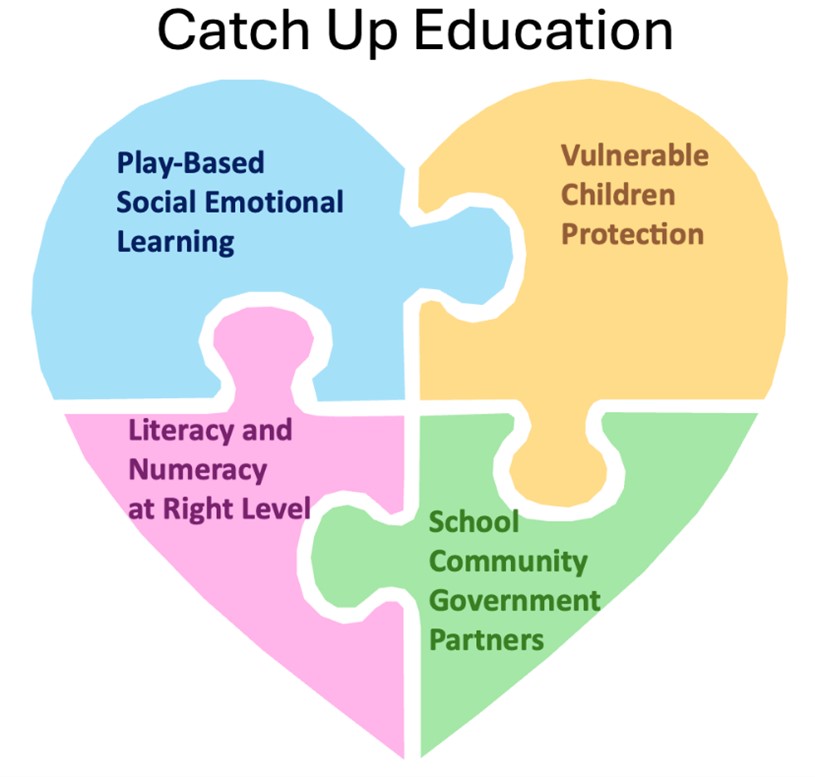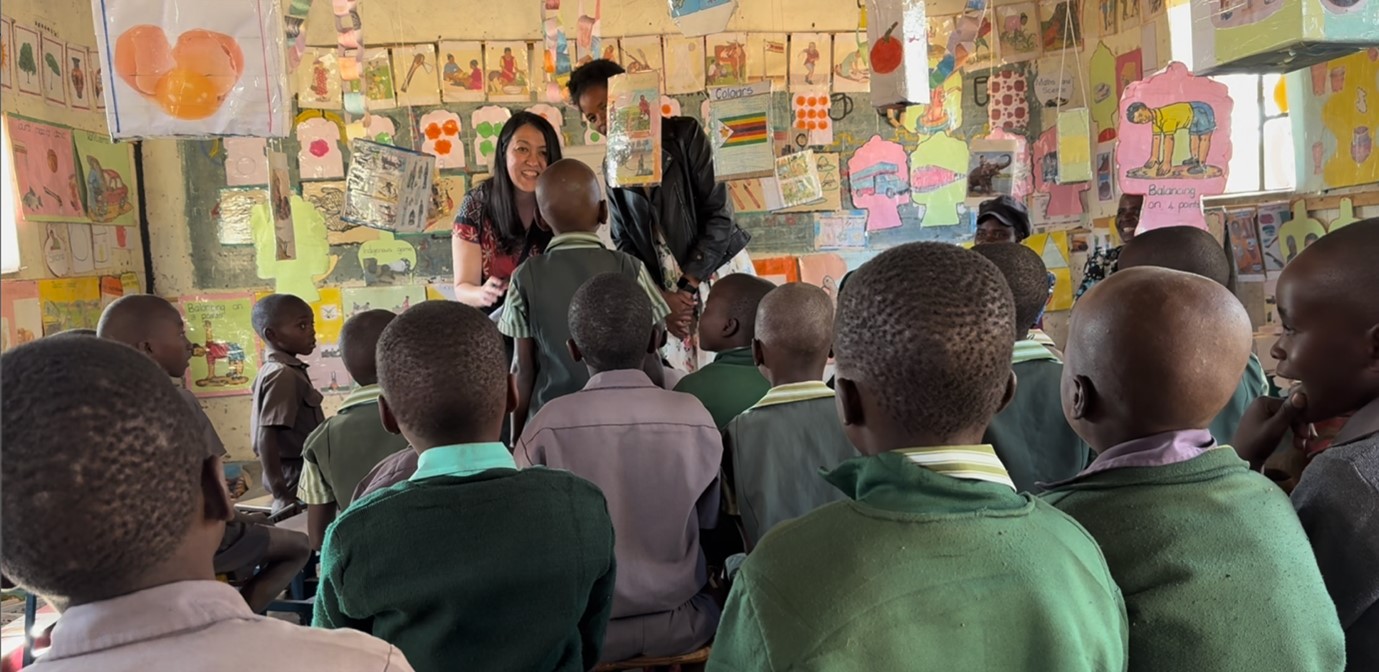Nearly a quarter of a billion school-aged children in crisis need urgent support for quality education, and 387 million primary-age children worldwide can’t read or do basic maths (ECW, 2024; UN, 2017). Across crisis-affected regions, Catch-Up Programmes (CUPs) are life-pathways for children whose education has been interrupted by conflict, climate shocks or displacement. Academic recovery alone is not enough. To thrive, children must also rebuild their confidence, reconnect socially, and develop the resilience and agency to keep learning in the face of adversity.
This two minute video presents a summary:
In general, resilience in education can be understood as students’ ability to recover from adversity, learn from experiences, and respond constructively to life’s challenges. Social and Emotional Learning (SEL) supports this by helping children understand emotions and build the self-confidence needed to cope with hardship and grow stronger. For SEL to be effective in crisis contexts, it must be rooted in children’s realities and made practical for those working directly with them (Okada, 2025; Jones and Kahn, 2017).
Social and Emotional Learning (SEL) is the process through which children develop the skills to understand and manage emotions, build relationships, seize opportunities and make responsible decisions. SEL has been promoted by CASEL (1994) and conceptualised by scholars such as Dewey, Vygotsky and Goleman, all of whom emphasise the importance of relationships, emotions and social interaction in learning. In crisis-adaptive contexts, our studies reconceptualise SEL as an evolving, situated capacity nurtured through care, agency and resilience in response to adversity.
To demonstrate the relevance of SEL in Catch-Up Learning, two contrasting examples highlight the need to reflect on and advance educational theory in the complex contexts of humanitarian settings (Okada, 2025).
An 8-year-old boy in Ethiopia entered the programme with low literacy and numeracy scores. Despite economic hardship, he made significant progress in numeracy, while literacy gains were modest and he has not yet graduated. However, his social-emotional development shows strong indicators – he engages actively, collaborates with peers, and confidently asks questions. In contrast, a 9-year-old girl in Zimbabwe, despite regular attendance and a sense of belonging within the CUP community, shows no academic improvement or progress. Her literacy and numeracy scores remain stagnant, and her social-emotional development is limited. She struggles to engage with peers, hesitates to seek help, and lacks confidence.
These contrasting stories reveal a critical fact: academic progress and social-emotional development may not always progress in parallel or align over time, yet both are essential for children’s long-term success. This complexity demands a framework that can address the whole child while remaining practical for crisis settings.
The Resilient Learning Ecology model, grounded on empirical studies, offers a fresh approach to SEL in emergencies. Instead of focusing only on individual skills, this model emphasises the interplay of emotional safety, embodied cognitive engagement, and growing agency, operationalised through the CARE-KNOW-DO framework.
What is the CARE-KNOW-DO Framework?
The CARE–KNOW–DO framework, which underpins the Resilient Learning Ecology model, provides a holistic approach to Social Emotional Learning (SEL) in emergencies. Rather than focusing solely on individual traits, it emphasises the dynamic relationship between emotion, cognition and social action. The framework translates three core concepts of the Resilient Learning Ecology into practical steps for programme design, intervention and formative assessment.

- The Zone of Emotional Safety (ZES) provides the foundation where children feel secure enough to learn. ZES is vital for students’ wellbeing, necessary for them to take care of their learning.
- Embodied Dialogue aims to engage every child through multiple modalities, helping them build meaning with body, mind and feelings and learn with joy, play and genuine understanding.
- Growing agency develops the capacity over time for independent action and choice-making, empowering children to do things that enhance their learning.
SELIC: Social and Emotional Learning in Context
To support practitioners in implementing this framework, the SELIC instrument (Social and Emotional Learning in Context) was developed for visualising current state and progress. It offers a visual and reflective tool for both formative assessment and learner engagement, helping facilitators observe, support and celebrate children’s holistic development.

The butterfly design symbolises how children’s social and emotional learning grows across the three domains (CARE, KNOW, DO), with TRY and CHOOSE at the core.
It consists of three interconnected domains:
- CARE: Creates a zone of emotional safety as inclusive spaces where children feel supported and valued. CARE ensures children feel safe, included and supported, enjoying learning when they feel part of a group.
- KNOW: Promotes playful and embodied dialogue, that is culturally relevant through learning experiences that engage children emotionally and cognitively. It represents core learning activities at the right level — singing, playing, using numbers, reading, writing and listening. These activities form the foundation of learning and connect across all the wings
- DO: Encourages meaningful participation and decision-making at the child’s own pace, to build growing agency. DO enables children to learn actively by asking questions, working independently, helping others, and engaging in fun activities.
These are supported by and contribute to two essential capacities:
- TRY (Resilience): Refers to the ability to persevere through challenges, learn from mistakes and remain motivated. With resilience, children keep trying, adapt to setbacks, and grow stronger in the face of adversity.
- CHOOSE (Agency): Refers to understanding the value of learning, making informed choices and engaging with purpose. With agency, children reflect on what they learn and take meaningful action toward building their future.
The instrument includes:
- An interactive version for children, using visual prompts, self-reflection, and colouring to express how they feel and learn.
- A structured version for facilitators and research collaborators to observe behaviours, assess emotional readiness, and plan responsive activities.
- An online version is also available: https://bit.ly/selic1
Fostering ‘CARE’ to build a zone of emotional safety
For children affected by trauma, instability or displacement, emotional safety is the foundation for all learning. ‘CARE’ focuses on creating environments where children feel secure, included and connected – where trust and consistency come before academic demands (Obradović et al., 2018).
How to implement ‘CARE’
Train facilitators to recognise and respond to signs of distress in children.
Establish predictable routines and rituals that foster a sense of belonging.
Use SELIC to prompt observation and dialogue – for example, ‘Do you feel safe?’ or ‘Do you feel comfortable?’ with response options ranging from ‘a little’ to ‘always’. Encourage peer support and create space for children’s voices to be
heard.
Impact
Children who experience ‘CARE’ are more likely to participate actively, take
risks and recover from setbacks. Statements such as ‘I feel safe when I am
learning’ reflect the crucial role of emotional security in educational
engagement.
Enhancing KNOW with Embodied Dialogue
Why embodied KNOWing matters
Learning is not just cognitive – it’s also emotional, embodied and social. In
crisis settings, children often express understanding through play, movement,
art and music, especially where language barriers exist making learning more difficult
(van der Kolk, 2014; Perry and Szalavitz, 2017).
How to
implement KNOW
Incorporate storytelling, singing, drawing, building and role-play into
sessions. Use SELIC prompts like ‘What activities do you enjoy most?’ or ‘Show
me how you learn with others’. Value engagement and creative expression as much
as teaching and formative assessment.
Impact:
Playful, inclusive learning promotes joy, participation and confidence.
Children become more willing to try, take initiative, and express
themselves – supporting both SEL and academic development.
Supporting DO for Growing Agency
Why DO
matters
Children already possess agency – the ability to act – but many need support to
become informed, gain confidence to express their choices, and access
opportunities to practise decision-making. This is especially important for
children recovering from instability or trauma, where rebuilding self-concept
and autonomy takes time. The ‘DO’ element of the CARE–KNOW–DO framework focuses
on creating opportunities for children to act independently, solve problems and support others – at their own pace and over time (Okada, 2025; Bandura,
2001; Biesta and Tedder, 2007).
How to implement DO
Encourage children to set personal learning goals, take on responsibilities or
teach their peers. Use the SELIC tool to reflect with prompts like: ‘Do
you help and learn from others?’, ‘Do you like to
learn on your own?’ Recognise and celebrate small steps toward
autonomy, initiative and leadership.
Impact
Gradually developing agency helps children shift from guided dependency to
increasing independence. As they succeed and feel supported, they gain
confidence and begin applying their learning beyond the classroom – contributing
positively to their communities and shaping their futures.
Translating SEL into action: programme design and assessment
Resilience and agency are not fixed traits but evolving capacities shaped by relationships, lived experiences and emotional support. The CARE-KNOW-DO framework embodies this developmental perspective, enabling children to grow in confidence, knowledge and purpose – even amid adversity during or after a crisis.
For NGOs, educators and humanitarian actors, this framework offers the following:
- A roadmap for designing new programmes or refining existing ones, grounded in emotional safety, playful learning and meaningful participation.
- A toolkit for formative assessment that values emotional wellbeing as foundational to educational progress.
- A practical method for observing, adapting and co-creating learning environments that empower children to learn and thrive despite adversity.
Through tools like SELIC, practitioners can embed social and emotional learning in ways that are context-sensitive, strengths-based and transformative.
This integrated research approach to support Catch Up Education will recognise that an Ethiopian boy’s growing confidence in asking for help and collaborating with peers may be as crucial as his numeracy progress. Likewise, a Zimbabwean girl may benefit from additional CARE-focused support to strengthen her confidence and peer relationships – key steps toward unlocking her literacy potential. By addressing care, knowledge and action together, the framework offers a more holistic pathway for supporting children’s development in crisis settings, where educational success depends on both academic achievement and social-emotional growth.





Rate and Review
Rate this article
Review this article
Log into OpenLearn to leave reviews and join in the conversation.
Article reviews